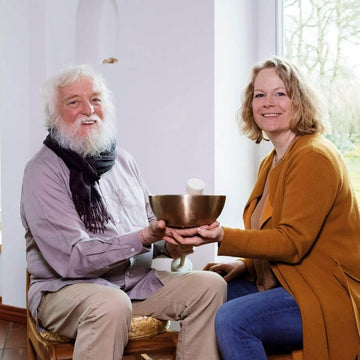Even children are drawn to harmonious sounds. The sound and gentle vibration of Singing Bowls can be used in various ways to promote perception, relaxation, increase concentration, and strengthen social skills. Therefore, Singing Bowls and forms of sound therapy for children can now be found in many families, kindergartens and schools, children's yoga classes, and occupational therapy practices.
Key points at a glance
- Sound therapy for children aims, among other things, to promote relaxation, concentration, and attention.
- Children learn about Singing Bowls best through play. These offer a lot of potential for this.
- Just like for adults, there are also Singing Bowl massages for children.
- In a pedagogical context, Singing Bowl games with children can take place in a variety of ways.
What is the goal of therapy with Singing Bowls for children?
Peter Hess, the founder of sound massage with Singing Bowls, developed the further education system "KliK® – Sounding Communication" together with his wife Emily Hess. With this system, children learn how to relax. In a Singing Bowl therapy for children, sensory and body perception are trained, attention and concentration are promoted, and mindfulness is practiced. In this way, children are given important resources that enable them to meet the diverse demands of our fast-moving times, to remain physically and mentally healthy and to maintain their joy of life and creativity.
Sound therapy for children can pursue various goals, such as promoting:
- Relaxation
- Concentration
- Attention
- Motivation
- Imagination and creativity
- Sensory and body perception
- Perception of one's own needs and those of others
- Expression of feelings
- Self-confidence and zest for life

How can I introduce Singing Bowls to children?
Children often perceive Singing Bowls as something special and valuable – especially when they are presented accordingly by adults. One way to introduce a Singing Bowl to children is, for example, to hide it under a cloth in a special place. First, the children are allowed to reach under the cloth with their eyes closed and guess what they sense there and what can be done with it. Once the secret is revealed, try together to make the Singing Bowl sound.
Singing, tapping or filling
Children are often wonderfully casual and open-minded when using Singing Bowls. The instrument can be made to sound in many ways and not just struck with a mallet as is traditionally done. Children can also sing to Singing Bowls and it sings along; you can gently tap them with your fingers and it sighs very quietly; you can fill them with small balls that rustle back and forth like the waves of the sea. And the great thing about it is that it always sounds different. Sometimes the sounds are deep and long-lasting, sometimes they are high and only sound very briefly.
"Children are our future. If we treat them with mindfulness and appreciation and offer them opportunities to develop joyfully and freely, the foundation for a peaceful future is laid."
Peter Hess
Apply to the body, place in or fill with water
Children can also place a Singing Bowl on their stomach or another part of their body, and if the Singing Bowl is large enough, they can even stand inside it. When it is then played, it tingles. Those who are quiet and listen carefully will notice how long a Singing Bowl can sound. It's also fun to fill the Singing Bowl with water and strike it vigorously – then a real "sound fountain" is created.
Experiments with fingers and mallets
What does it sound like when you tap the bowl with the ball of your hand or when your fingernails dance over it? What is it like when you tap it with a felt mallet or swing grains of sand or lentils back and forth inside with a friction mallet or a rubber mallet? There are no limits to your imagination here, try out what you and the children come up with. Anything is allowed - except pointed or hard objects that could damage the surface. After some time, let the Singing Bowl sound properly for the first time and ask the children to listen to the sound - not only with their ears, but with their whole body.

Are there Singing Bowl massages for children?
Yes, as with a normal sound massage, in a Singing Bowl massage for children, Therapy Singing Bowls are positioned on or around the body according to a specific system and gently struck. Adults and children alike usually enjoy the fine tingling of the sound vibration and the quiet fading of the harmonious sounds from the very first moment of a sound massage, which quickly leads to relaxation. Feelings of satisfaction, serenity and inner peace often arise.
What happens during a Singing Bowl massage for children?
In a Singing Bowl massage for children, the body is relaxed by the sounds and the mind comes to rest – the soul experiences space to unfold. The vibrations emanating from the sounding and thus vibrating bowls gradually spread throughout the body via the skin, tissue, organs, body fluids and body cavities. Our body, which consists of about 70 percent fluid, reacts accordingly sensitively to this fine stimulation. The sounds literally set it in motion, in flow. The fine vibration impulses gently loosen muscular tension, adhesions in the fascia tissue and stimulate blood circulation and lymph flow.
Many people describe their experience during a sound massage as "a kind of very fine cell massage" that has a soothing effect deep inside the body. For children, the Singing Bowl massage can also feel like the "tingling of a thousand sunbeams in the stomach". In general, the following effects can be summarized.
The Singing Bowl massage:
- is a holistic method that addresses body, mind and soul
- creates a deep relaxation
- strengthens people's original trust
- facilitates "letting go" – of worries, fears and doubts
- contributes to health promotion: harmonization, regeneration and vitalisation
- supports and improves body and self-awareness
- contributes to the activation of self-healing powers
- enables access to and use of own resources
- strengthens self-confidence, creativity, creative power and motivation
How long does a Singing Bowl massage for children last?
A classic Singing Bowl massage lasts about an hour, including a preliminary discussion and after-rest. Various short Singing Bowl massage sessions have been designed for working with children, depending on the child's age and personality. Such Singing Bowl massages for children are taught, for example, in the seminar "Singing Bowl Massage with Children – Experiencing the Touch of All Senses with Children Anew." The seminar builds on the training seminar "Singing Bowl Massage I – Strengthening Your Own Center" and teaches many variations of the classic basic Singing Bowl massage specifically for children. But of course, children or teenagers can also give each other a small Singing Bowl massage – or give one to their parents, which especially fills the little ones with pride.
Many adults are always amazed at the sensitivity and mindfulness that children show when giving a Singing Bowl massage. Here too, the following applies: Every experience is individual and can be very different from child to child.
Sound and imagery journeys with children
Children love sounds and children love imagery journeys and stories – so what could be more natural than combining these two elements into sounding imagery journeys? Children usually reach a state of deep relaxation much faster than adults and at the same time follow the text very consciously. They often experience and live through the imaginative stories in the moment.
The sounds not only promote relaxation and strengthen attention, but also have a positive effect on concentration, memory and endurance. Selected imagery journeys can help children to better process inner states of tension, fears and experiences, thus becoming a valuable resource in terms of coping with life and self-confidence.
"Imagination is more important than knowledge, because knowledge is limited. Imagination, however, encompasses the whole world."
Albert Einstein

Singing Bowl games with children in an educational context
The diverse Singing Bowl games with children, sound exercises and sound settings can be ideally integrated into educational and upbringing plans as well as curricula. They enrich the respective pedagogical concepts and, as a non-verbal communication and expression medium, playfully help to overcome linguistic or cultural barriers. Accordingly, they have also proven their worth as a complementary offer in integrative facilities. Educators, teachers and parents not only appreciate the beneficial effect on children and the general atmosphere, but also that they themselves benefit from the sounds. The Singing Bowl games with children also become valuable recovery phases for them in often stressful and noisy everyday life.
"To ensure that the enormous potential for networking in the brain can be stabilized as well as possible and that the talents inherent in our children can unfold, we must give them the opportunity to play for as long as possible."
Gerald Hüther
Sound-filled breaks in kindergarten
Children are often exposed to many stimuli that they cannot always adequately filter or process. In kindergarten, a relatively high noise level is part of everyday life – some children cope better with it, others less so. Large groups of up to 25 children pose a challenge, especially for the little ones. Educators who face these stressors themselves every day can tell you a thing or two about it. Here, small sound breaks, which repeatedly lead to calm, focus attention and bring all participants into contact with themselves, are particularly beneficial.
The intensive training to become a KliK® expert/practitioner – Sounding Communication with Children, which is primarily aimed at pedagogical or therapeutic professionals, offers comprehensive information and practical tips.
Sound as support in everyday school life
The desire for learning and growth is inherent in all of us from the beginning. Preserving the natural joy of learning is not always easy, because societal influences and performance-related thoughts have an impact on the learning process early on. Lack of concentration, high expectations and pressure to perform show their effects on students, parents and educators, and quickly lead to dissatisfaction, tension and stress. KliK® would like to create a counterpoint here that offers relaxation, supports the joy of learning and helps to strengthen concentration and endurance. It is always also about the personal development of children and adolescents, about discovering and cultivating resources that can sustainably support them on their life path.
Singing Bowl games with children and other sound offers can be used not only in the classroom, but also in the context of working groups, in after-school care, school social work or by school psychologists.
Whether in elementary school or in upper school, experience shows that sound methods are a useful addition to the teaching process. Their targeted use can take place in different situations and with different goals, for example:
- Use of Singing Bowls for learning motivation and better learning
- Learning with all senses
- Sound rituals and sound innovation (at the beginning of class, during class, during breaks, before class tests or exams, as a daily conclusion)
- Promoting concentration
- Supporting integration and inclusion with sound
- Strengthening social learning and mindfulness
- Accompanying the handling of conflict situations






